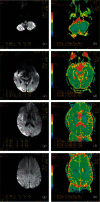The Evaluation Value of Diffusion-Weighted Imaging for Brain Injury in Patients after Deep Hypothermic Circulatory Arrest
- PMID: 35685655
- PMCID: PMC9162866
- DOI: 10.1155/2022/5985806
The Evaluation Value of Diffusion-Weighted Imaging for Brain Injury in Patients after Deep Hypothermic Circulatory Arrest
Abstract
Objective: Cerebral complications may occur after surgery with deep hypothermic circulatory arrest (DHCA). Diffusion-weighted imaging (DWI) has shown promising results in detecting early changes of cerebral ischemia. However, studies in human models are limited. Here, we examined the significance of DWI for detecting brain injury in postoperative patients after DHCA.
Methods: Twelve patients who had undergone selective cerebral perfusion with DHCA were enrolled. All patients underwent magnetic resonance imaging (MRI) examinations before and after the operation with T1-weighted phase (T1W) and T2-weighted phase (T2W). Magnetic resonance angiography (3D TOF) was applied to observe intracranial arterial communication situations. DWI was employed to calculate the apparent diffusion coefficient (ADC) values. The neurocognitive function of patients was assessed preoperatively and postoperatively using the Montreal Cognitive Assessment Scale (MoCA), Hamilton Depression Scale (HAMD), and Hamilton Anxiety Scale (HAMA).
Results: The ADC values of the whole brain of patients after surgery were significantly higher than before surgery (P = 0.003). However, no significant difference in the ADC values of other regions before and after the operation was observed. There was no significant effect on the postoperative cognitive function of patients after surgery, but visual-spatial and executive abilities were significantly reduced, while psychological anxiety (P = 0.005) and depression levels (P < 0.05) significantly increased. Correlation analysis revealed a significant association between ADC change values and depression change values (P < 0.05).
Conclusion: DHCA demonstrated no significant effect on the cognitive function of patients but could affect the mood of patients. On the other hand, DWI demonstrated promising efficiency and accuracy in evaluating brain injury after DHCA.
Copyright © 2022 Jiaxiang Zhuang et al.
Conflict of interest statement
The authors declare that they have no conflict of interest.
Figures


Similar articles
-
Diffusion-weighted imaging detects early brain injury after hypothermic circulatory arrest in pigs.Interact Cardiovasc Thorac Surg. 2018 Apr 1;26(4):687-692. doi: 10.1093/icvts/ivx392. Interact Cardiovasc Thorac Surg. 2018. PMID: 29244151
-
Neurological injury after neonatal cardiac surgery: a randomized, controlled trial of 2 perfusion techniques.Circulation. 2014 Jan 14;129(2):224-33. doi: 10.1161/CIRCULATIONAHA.113.003312. Epub 2013 Oct 20. Circulation. 2014. PMID: 24141323 Clinical Trial.
-
Association of Ongoing Cerebral Oxygen Extraction During Deep Hypothermic Circulatory Arrest With Postoperative Brain Injury.Semin Thorac Cardiovasc Surg. 2022 Winter;34(4):1275-1284. doi: 10.1053/j.semtcvs.2021.08.026. Epub 2021 Sep 8. Semin Thorac Cardiovasc Surg. 2022. PMID: 34508811 Free PMC article.
-
Similar cerebral protective effectiveness of antegrade and retrograde cerebral perfusion during deep hypothermic circulatory arrest in aortic surgery: a meta-analysis of 7023 patients.Artif Organs. 2015 Apr;39(4):300-8. doi: 10.1111/aor.12376. Epub 2015 Mar 4. Artif Organs. 2015. PMID: 25735404 Review.
-
Effect of Deep Hypothermic Circulatory Arrest Versus Moderate Hypothermic Circulatory Arrest in Aortic Arch Surgery on Postoperative Renal Function: A Systematic Review and Meta-Analysis.J Am Heart Assoc. 2020 Oct 20;9(19):e017939. doi: 10.1161/JAHA.120.017939. Epub 2020 Sep 29. J Am Heart Assoc. 2020. PMID: 32990132 Free PMC article.
Cited by
-
Optimization of Hypothermic Protocols for Neurocognitive Preservation in Aortic Arch Surgery: A Literature Review.J Cardiovasc Dev Dis. 2024 Aug 1;11(8):238. doi: 10.3390/jcdd11080238. J Cardiovasc Dev Dis. 2024. PMID: 39195146 Free PMC article. Review.
-
Volumetric apparent diffusion coefficient histogram analysis in term neonatal asphyxia treated with hypothermia.Br J Radiol. 2024 Jun 18;97(1159):1302-1310. doi: 10.1093/bjr/tqae105. Br J Radiol. 2024. PMID: 38775658 Free PMC article.
-
Impact of Hypoxia-Ischemia on Neurogenesis and Structural and Functional Outcomes in a Mild-Moderate Neonatal Hypoxia-Ischemia Brain Injury Model.Life (Basel). 2022 Jul 30;12(8):1164. doi: 10.3390/life12081164. Life (Basel). 2022. PMID: 36013343 Free PMC article.
-
Experiences of Cardiovascular Surgery Intensive Care Nurses in the Care of Patients With Postoperative Cognitive Dysfunction: A Qualitative Study.Inquiry. 2025 Jan-Dec;62:469580251332061. doi: 10.1177/00469580251332061. Epub 2025 Apr 12. Inquiry. 2025. PMID: 40219782 Free PMC article.
References
-
- DALYs G. B. D., Collaborators H. Global, regional, and national disability-adjusted life-years (DALYs) for 359 diseases and injuries and healthy life expectancy (HALE) for 195 countries and territories, 1990-2017: a systematic analysis for the Global Burden of Disease Study 2017. Lancet . 2018;392:1859–1922. doi: 10.1016/S0140-6736(18)32335-3.10159 - DOI - PMC - PubMed
Publication types
MeSH terms
LinkOut - more resources
Full Text Sources
